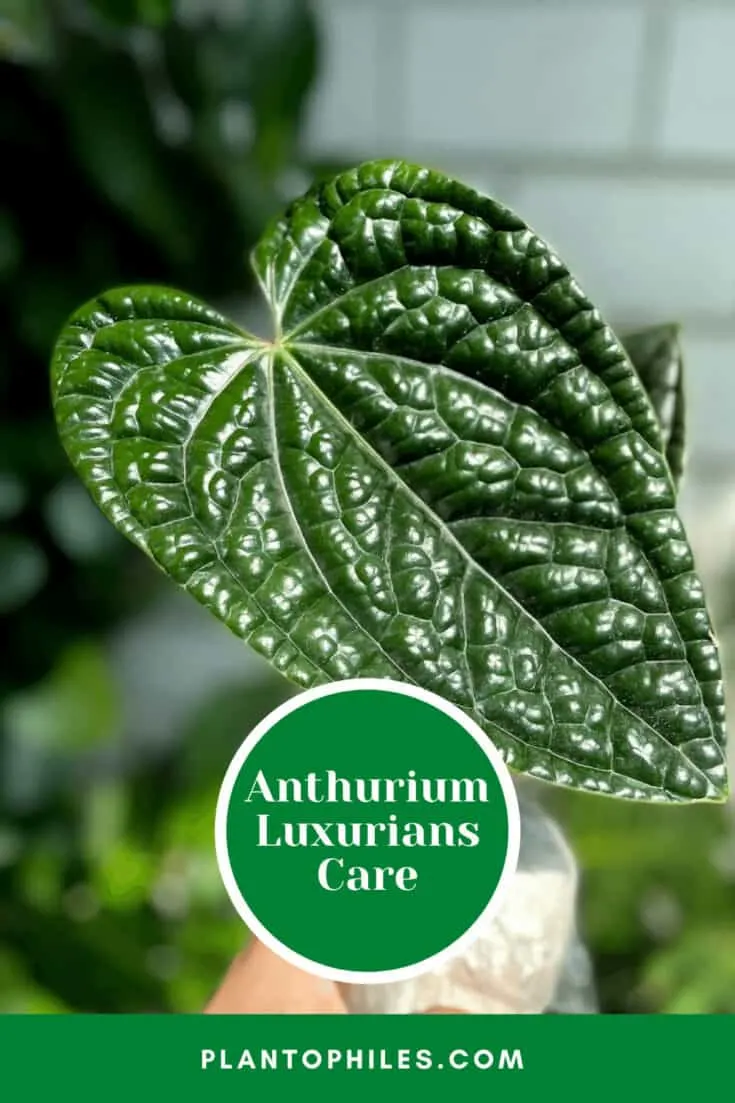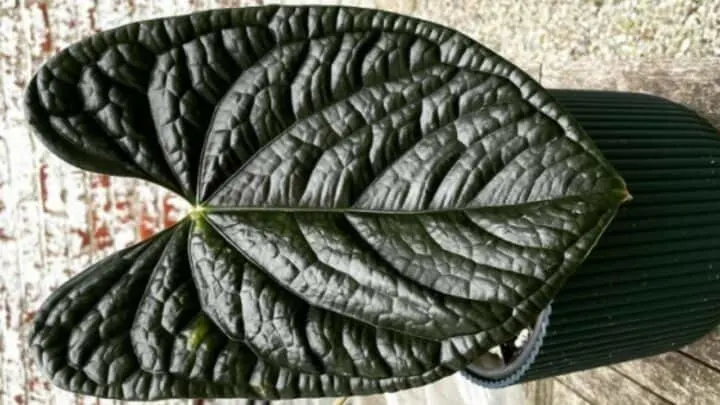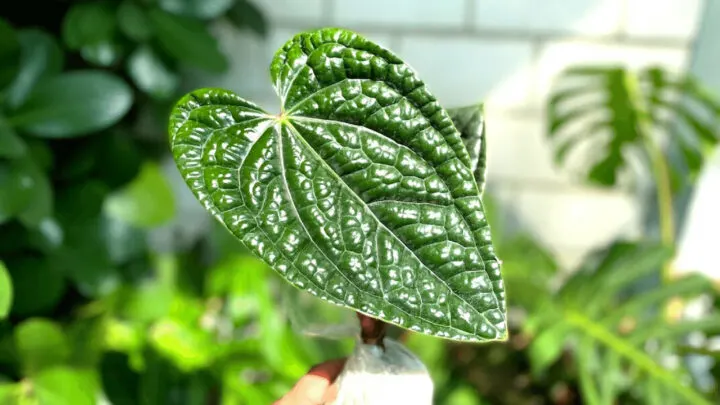Anthurium Luxurians was discovered growing along the streams of rainforests in Columbia.
This plant has a sophisticated but aesthetical appearance with its puckered deep green leaves.
For a long time, it was considered Anthurium Splendidum because of its close resemblance.
The textured surface reflects light making the plant look more vibrant and green. Young leaves are light, but they become dark green as the plant matures.
This is one of the rarest Anthurium with a luxurious look.
But it’s also heavy on the pocket, and you will even find it selling for $1500.
Described by Richard N. Cirino and Thomas B. Croat, this plant was first introduced in 2005.
Today, plant lovers and collectors enjoy growing this as a houseplant.
This article shares the basic information required to keep this Anthurium happy in your house.
Table of Contents
Anthurium Luxurians Care
Anthurium Luxurians demands less light and more humidity than most Anthurium. Hence, grow it under indirect sunlight with up to 80% humidity. The potting mix should contain bark and perlite to keep the soil airy. The temperature required for the best growth of this plant is 70-90 degrees Fahrenheit (21 to 32 degrees Celsius). Feed only 2-3 times a year using fertilizer at 1/4 of the recommended strenght.
Soil
Like many other aroids in the Araceae family, this one also needs a well-draining growing medium. Outdoors as well this plant requires excellent drainage.
An orchid mixture with peat and sand is great for this plant. You can add perlite to this mixture. You can also spread a layer of moss on the soil surface.
The key to keeping this Anthurium happy is an airy mixture.
I have been using the following recipe for most of my potted Anthuriums, and they have been thriving ever since:
- Potting soil (20%)
- Bark (50%)
- Perlite (30%)
Water
This Anthurium is a challenge in terms of watering. This plant has moderate to high water needs.
So keep checking the soil every now and then to avoid a completely dry soil mixture.
Watering it every nine days will ensure your plant always has adequate moisture for growth. This applies if you keep the plant under moderate sunlight and temperature.
Higher temperature and light mean higher water demands.
If you live in a harsh climate with extreme temperatures during growing months, water this Anthurium every three days.
Creating a water-retaining potting mixture will save you the hard work of watering your plant every other day.
Keep in mind that this plant loves moisture, creating a perfect opportunity for bacteria and pest growth.
Light
Your Anthurium Luxurians will struggle with growth and leaf development if you do not maintain ample light. You will also notice significant leaf loss. It needs at least 70% sun.
This plant needs indirect sunlight, but keeping it too far from the light source is not good. I would suggest placing the pot 3 ft or less from a bright window in your house.
In case you suspect your plant will get intense light, you can install sheer curtains on the window to reduce the light intensity.
If your plant is growing outside, shift it to a spot with partial shade during the summer months. The harsh sun during the summer months can burn the foliage of the Anthurium Luxurians.

Anthurium Luxurians
Temperature
Based on its native regions, the optimum temperature is 70 to 90 degrees Fahrenheit (21 to 32 degrees Celsius).
This tropical aroid needs protection from cold temperatures.
If the outdoor temperature constantly remains below 50 degrees Fahrenheit or 10 degrees Celsius, you can shift your plant to a heated location indoors. But never keep it too close to a heater or air conditioner.
This Anthurium is hardy in USDA hardiness zone 11.
Humidity
This Anthurium is a humidity-loving plant that likes indoor areas with humidity of about 80%.
Spray the foliage with a plant mister every other day, depending on the climate of your house.
If you feel that will be a time-consuming task, you can buy a humidifier that will automatically raise the humidity.
Fertilizer
This Anthurium does not require a lot of feeding.
This also means it cannot tolerate overfeeding.
Feeding this plant 2-3 times a year in the growing months is all it needs to flourish.
You can use any regular houseplant fertilizer designed for Anthuriums. It should be diluted at ¼ strength, especially for the potted plants.
Repotting
Repot this Anthurium whenever it doubles in size. You should also repot if the roots have started growing at the soil surface.
Most growers agree that repotting after one year is beneficial for the growth of the Anthurium Luxurians.
You have to use a bigger pot for repotting. Ideally, one size bigger pot is enough.
Pruning
This plant has steady growth but stays compact. This plant does not require heavy or regular pruning.
You will have to prune it to remove discolored foliage to conserve plant energy for healthy leaves.
Prune the plant with clean and sharp pruning shears to prevent any damage.
Propagation
Take your plant out from the pot and soil medium. Inspect the root system to find the perfect spot to take a cutting.
You might come across root sections that divide into two leaves or petiole. I’d recommend taking the cutting from this location.
If not, take a healthy cutting from anywhere without damaging other healthy leaves and roots.
Avoid separating the cutting by hand or pulling as this can damage both the mother plant and the new cutting.
Use a sharp knife, but clean it with a rubbing alcohol solution to kill harmful bacteria or fungus.
Avoid using a dull tool because you might end up breaking the cutting. Do not make deep cuts; otherwise, bacteria can start growing in the cuts.
You can put cinnamon powder at the cut to prevent bacteria. The cinnamon will also help in drying the cut faster.
Now you can root the cutting in a soilless medium such as leca or a soil-based medium. You can also plant it in perlite so that the roots can stay moist for longer.
I would highly recommend placing the cutting under high humidity inside a greenhouse or grow tent.
Otherwise, continuously run the humidifier near the cutting or cover it with a plastic sheet to secure moisture inside.
If you maintain the correct temperature and light, your cutting will show signs of growth in 3-4 weeks.
Once your cutting develops several new leaves, you can propagate them into individual pots.
As we know, Luxurians is an expensive plant; you can gift these new cuttings to a plant friend or sell them online.
Blooms
This plant also produces inflorescence-shaped blooms, which consist of a creamy white spathe and green spadix. The veins are also green.
This plant is all about the leaves, and the inflorescence is nothing compared to the dramatic bullate leaves.
Growth
The ovate-shaped leaf blades have a bumpy surface. The foliage’s upper surface is dark green, while the underside’s lime green.
The lower side of the leaves is sunken, but the leaf veins are visible.
The plant shifts leaf color in an interesting pattern. The new growth is red or pink-colored.
As the leaf grows, it changes to a beautiful shade of brown or bronze-green. The final color of the leaf is dark black-looking green with a tinge of blue in it.
Mature foliage measures 2.1 ft (65 cm) in length and 1.6 ft (50 cm) in width, so this plant produces huge leaves.
The stem and internodes are short, so this plant has a dense appearance when it’s mature and full of leaves.
The bullate texture of the leaves also enhances as the plant matures. Each winged petiole on this plant has about nine ribs.
The only drawback is the slow-growing nature. You will have to wait for 2-4 months to see a new baby leaf.
Unique Anthuriums for Indoor Gardening
Anthurium Radicans
This is a low-maintenance Anthurium with puckered leaves.
This plant will reach a maximum size of 20 inches.
Anthurium Crystallinum
This one has solid green leaves with silvery-white venation.
These heart-shaped leaves love high humidity.
Anthurium Veitchii
This is a giant Anthurium with 6 ft long leaves. The leaves are glossy and have ridges throughout the surface.
However, it grows really slow, so even a single leaf takes several months.
Tulip Anthuriums
You will instantly fall in love with pink and purple blooms of this variety.
This Anthurium is small-sized, which makes it an excellent choice for gardening indoors.
View this post on Instagram
Common Problems for Anthurium Luxurians
Improper Light
Despite their thick leaves, Anthurium Luxurians can get sunburns if they are exposed to direct sunshine.
If your Anthurium’s leaves are turning yellow, it’s time to prune them. If the tips appear to discolor and become brown, there are chances the plant is getting too much sunlight.
Furthermore, if the plant appears to be growing slowly and producing few leaves, it could be due to a lack of light.
Anthurium Luxurians will withstand any level of indirect bright light.
You can put your plant in a window sill where it gets bright light but not direct sunlight.
Inadequate Fertilization
You can use fertilizer to help your Anthurium Luxurians grow faster, but too much fertilizer might lead to problems.
Excess fertilizer causes the soil to become acidic. Nitrogen overdose is a typical problem.
Excess of nitrogen encourages leaves but hinders inflorescence formation, in addition to the risk of leaf burn.
Overfertilization also causes leaf burning, which begins as browning at the margins and ends in the complete destruction of the foliage.
The Anthurium Luxurians is not a heavy feeder, and giving it too much fertilizer will only cause problems.
Always fertilize the plant by diluting it to half strength and after 2 to 3 months.
Watering Issues
Fungus might ruin your Anthurium Luxurians if you don’t water it properly.
When the roots can’t access air, fungi and other anaerobic microorganisms thrive.
Leaf blight can spread rapidly if the leaves remain damp after watering. It’s critical to make sure your Anthurium gets adequate water and doesn’t dry out completely.
Water your Anthurium Luxurians when you feel the soil’s top 1-2 inches are dry.
Anthurium Luxurians should be watered after 2 to 3 days during the hot summer season as water evaporates very rapidly. While watering it once a week during winter will be just fine.
Pests
While pests are a far bigger issue for outdoor Anthurium Luxurians, your indoor plant is also vulnerable to pest infestation.
Since this Anthurium has thick foliage, it’s not an easy target for nibbling pests. Sucking pests will more likely feast on this plant.
Some of the most prevalent pests that can attack your Anthurium Luxurians are mealybugs, spider mites, thrips, and scales.
They all suck the important juices out of the plant, making it weak and leggy.
Keep a close eye on your plant to catch any pest infestation in the early stages. Along with that, clean the foliage with a Pyrethrin-based pesticide or use horticultural soap.
You can also use neem oil to deal with pests.
Tips for Growing Anthurium Luxurians
- Airflow within the soil and around the plant is critical to keep it thriving as an indoor or outdoor plant.
- Avoid direct sunlight both indoors and outdoors as it can damage the leaves and blooms.
- This Anthurium likes warmth, but too much of it can cause wilting. So avoid exposing it to temperatures higher than the 90-degree Fahrenheit mark.
- This plant loves being watered, but you still need to ensure the potting or garden soil dries out between the watering. A moisture meter is a useful device that helps you water your houseplants on time.
- Feeding at the right time will help your plant grow fast but spread the fertilizers 6 inches away from the base of your Anthurium to avoid fertilizer burns.
Frequently Asked Questions about Anthurium Luxurians Care
Can I grow the Anthurium Luxurians in a terrarium?
Growing this plant in a terrarium will help you in fulfilling the high humidity demand. But as the leaves can get really big, ensure that the terrarium’s around 18 inches in size.
What can protect my Anthurium Luxurians from fungus and bacteria in soil?
Adding charcoal to the potting soil will keep your soil and your plant free from bacteria and fungus.
Conclusion
The puckered and leathery finish of the leaves for this Anthurium makes it highly desirable among plant lovers.
The leaves are initially chocolate-colored and soon turn into deep green under the right conditions.
These leaves have a shiny surface, and they are quite sturdy.
This plant is our top recommendation if you are looking for something with textured leaves. However, this unusual plant is for experienced gardeners.
We have several articles related to Anthuriums that will help your gardening journey.

Daniel has been a plant enthusiast for over 20 years. He owns hundreds of houseplants and prepares for the chili growing seasons yearly with great anticipation. His favorite plants are plant species in the Araceae family, such as Monstera, Philodendron, and Anthurium. He also loves gardening and is growing hot peppers, tomatoes, and many more vegetables.



